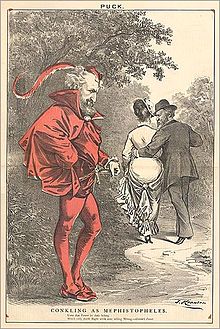- Compromise of 1877
-
 A political cartoon by Joseph Keppler depicts Roscoe Conkling as Mephistopheles, as Rutherford B. Hayes strolls off with a woman labeled as "Solid South". The caption quotes Goethe: "Unto that Power he doth belong / Which only doeth Right while ever willing Wrong."
A political cartoon by Joseph Keppler depicts Roscoe Conkling as Mephistopheles, as Rutherford B. Hayes strolls off with a woman labeled as "Solid South". The caption quotes Goethe: "Unto that Power he doth belong / Which only doeth Right while ever willing Wrong."
The Compromise of 1877, also known as the Corrupt Bargain,[1] refers to a purported informal, unwritten deal that settled the disputed 1876 U.S. Presidential election and ended Congressional ("Radical") Reconstruction. Through it, Republican Rutherford B. Hayes was awarded the White House over Democrat Samuel J. Tilden on the understanding that Hayes would remove the federal troops that were propping up Republican state governments in South Carolina, Florida and Louisiana. Consequently, the incumbent President, Republican Ulysses S. Grant, removed the soldiers from Florida before Hayes as his successor removed the remaining troops in South Carolina and Louisiana. As soon as the troops left, many Republicans also left (or became Democrats) and the "Redeemer" Democrats took control.
Compromise
The purported compromise essentially stated that Southern Democrats would acknowledge Hayes as President, but only on the understanding that Republicans would meet certain demands. The following elements are generally said to be the points of the compromise:
- The removal of all federal troops from the former Confederate States. (Troops remained in only Louisiana, South Carolina, and Florida, but the Compromise finalized the process.)
- The appointment of at least one Southern Democrat to Hayes's cabinet. (David M. Key of Tennessee became Postmaster General.) Hayes agreed.
- The construction of another transcontinental railroad using the Texas and Pacific in the South (this had been part of the "Scott Plan," proposed by Thomas A. Scott, which initiated the process that led to the final compromise).
- Legislation to help industrialize the South.
In exchange, Democrats would:
- Accept Hayes's presidency.
- Respect blacks' rights.
In fact, as regards the first and most important point, Hayes had already announced his support for the restoration of "home rule", which would involve troop removal, before the election. It was also not unusual, nor unexpected, for a President, especially one so narrowly elected, to select a cabinet member favored by the other party. As for the final two points, if indeed there was any such firm agreement, they were never acted on.
In any case, whether by a semi-formal deal or simply reassurances already in line with Hayes's announced plans, talks with Southern Democrats satisfied the worries of many and so prevented a Congressional filibuster that had threatened to extend resolution of the election dispute beyond Inauguration Day 1877. There was no serious effort made to fund a railroad or provide other federal aid. An opposing interest group representing the Southern Pacific successfully thwarted Scott's Texas and Pacific scheme and ultimately ran its own line to New Orleans.
Historians argue that the assurances offered to some Southern Democrats to prevent a filibuster were not a "compromise"(Peskin, 1973). Others argue that the Republican party abandoned Southern Blacks to racist Democratic party rule in order to gain Democratic support(DeSantis, 1982). In any case, Reconstruction ended, and the supremacy of the Democratic Party in the South was cemented with the ascent of the "Redeemer" governments that displaced the Republican governments. After 1877, white supremacy generally caused the South to vote Democratic in elections for federal office (the "Solid South") until 1966.
Whatever "deals" may or may not have taken place, in formal legal terms, the election of 1876 was not decided by such acts, but by the official vote of Congress to accept the recommendations of the Electoral Commission they themselves had set up as a way out of the election impasse. The expectation in setting up the committee had been that its decisions would be accepted by congress. It was only when certain Democrats disagreed with the commission's decisions in favor of Hayes that this arrangement was jeopardized. This group threatened a filibuster (opposed by Republicans and Congressional Democratic leadership as well) that would prevent the agreed upon vote from even taking place. Discussions of the points in the alleged "compromise" only concerned convincing key Democrats not to acquiesce in a filibuster. The very threat of a filibuster—a measure used by a minority to prevent a vote—indicates that there were already sufficient votes for accepting the commission's recommendations.
References
- ^ "Election 2000 much like Election 1876", Wes Allison, St. Petersburg Times, November 17, 2000.
External links
Categories:- History of the Southern United States
- Reconstruction
- 1877 in the United States
Wikimedia Foundation. 2010.
